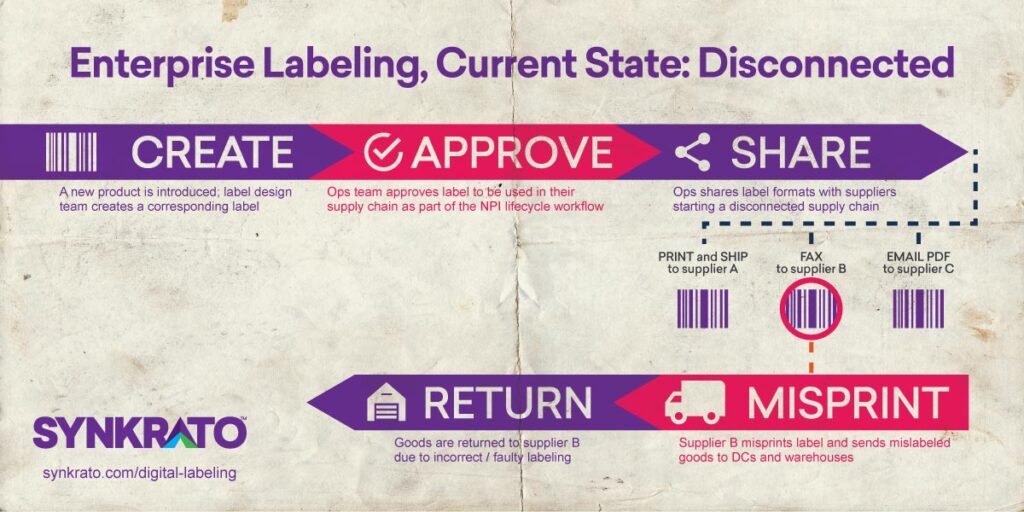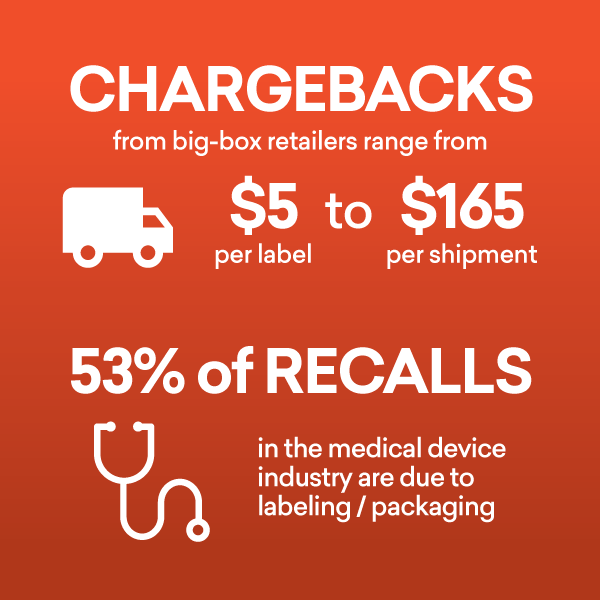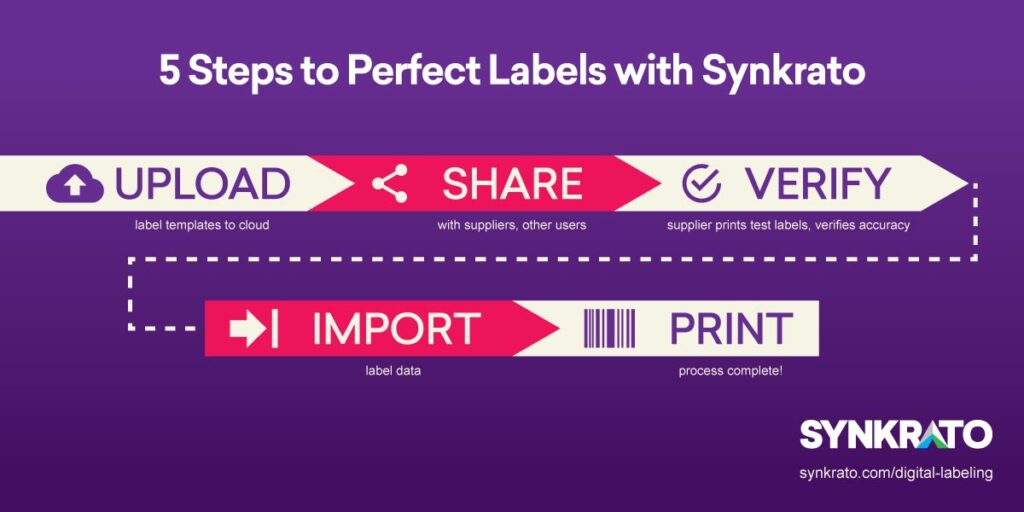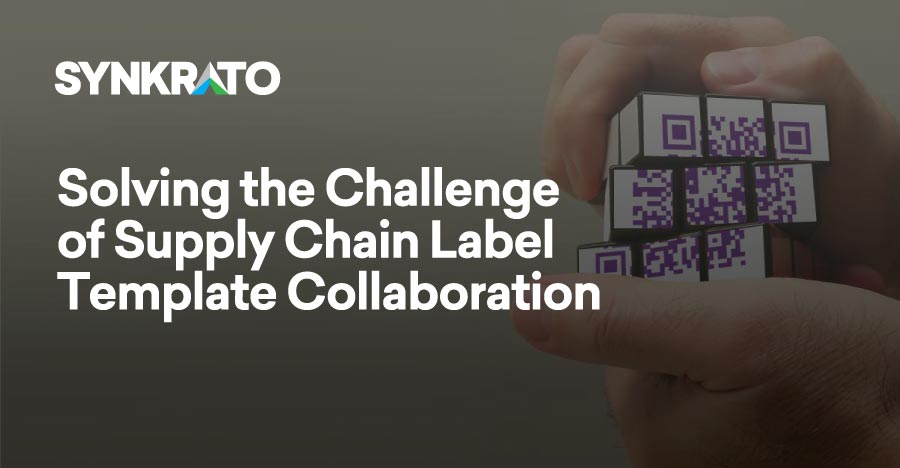While many excellent tools are available for enterprise label design, networked printing, and facility routing, few solutions address one of the biggest challenges in enterprise labeling: effective supply chain label template collaboration.
Label design is not the area where most organizations struggle. An enterprise may have one or two label designers who work with the marketing and regulatory teams and with external suppliers. They collaborate to design labels for finished goods or work with the logistics team to design labels for warehouse use, for example, license plates, locators, and receiving and shipping labels

Current State of Typical Enterprise Labeling Process: Disconnected
However, after labels are designed, few tools in the marketplace allow for effective label template collaboration and sharing of labels, both within and outside the enterprise. For example, if your enterprise involves a lot of outsourced manufacturing, you want to ensure suppliers are conforming to your standards and are using your label formats. Typically, this process necessitates sharing label templates with suppliers, having those suppliers recreate the templates in their system, and then you would review and validate the supplier templates. If a change is needed in one of the labels, this entire cycle repeats sometimes adding weeks or months to the process.
The lack of a label template collaboration solution also creates problems within a single enterprise. Global corporations with facilities around the world face the same issues with template sharing and management. Labels have to be printed at different locations and may have different localized requirements. Quite frequently each facility has its own localized labeling solution which has to be synchronized with other business units. As you can imagine, label maintenance and change management quickly become onerous and time consuming, again leading to misprints and increased risks and costs
Disconnected is Inefficient and Costly
Labels are the grease keeping the supply chain wheels turning smoothly, and the costs of incorrect labels can be considerable. Starting in receiving, an incorrect label can slow down all processes in the entire supply chain, leading to productivity loss, an increase in errors, and wasted resources. We have even seen some companies print labels and physically mail them to their suppliers. A slow and anachronistic process to be sure, especially in the cloud-connected age we live in.
Misprinted label costs are well documented and quite considerable. Chargebacks from big-box retailers can range from $5 per label to $165 per shipment. These costs quickly add up and destroy profits, especially in a low-margin industry like retail. In a regulated industry like food or medical devices, the costs are exponentially higher. Incorrect labeling / packaging is the number one reason for recalls and the costs can soar into hundreds of millions of dollars.

In the medical device industry 53% of all recalls are due to labeling / packaging issues. Most labeling errors are due to a lack of effective collaboration and change management across the extended supply chain. Labels may not have been updated to follow the latest regulations, or perhaps the form, fit, or function of the product changed, but the labels were not updated to reflect those changes. More commonly however, labels are updated but the changes are not propagated to all parts of the enterprise and to suppliers in time.
Quite a few tools in the marketplace focus on label authoring and design and these tools do an excellent job supporting different barcode formats and industry standards. However, it has frequently been our experience that enterprises often end up using these tools as multiple, disparate, standalone solutions. An enterprise may have one tool for authoring labels and change management, and that tool may even integrate with one of their other systems.
But when they need to collaborate with customers or suppliers or with multiple, different systems, they essentially have to stitch these different tools together and build their own integration infrastructure. This integrated effort requires specialized knowledge of not only the labeling systems but also the different systems with which they must be integrated. The end result is that the labeling process becomes unnecessarily complicated. Fortunately, Synkrato digital labeling eliminates these inefficient build-your-own-infrastructure approaches by focusing on fast, easy collaboration.
The Fix: Tools for Effective Collaboration and Label Sharing
In creating Synkrato digital labeling, our goal was to completely rethink enterprise labeling management: “what if we could manage the entire label lifecycle in one place, where all users could work together on the same labels?” Synkrato labeling offers simple-to-use, cloud-based, centralized label template management, collaboration, and automation. We have separated label design from the rest of the label life cycle so that label designs can be built in the tool of your choice (e.g., Zebra Designer for XML) and then uploaded to the cloud. If you already have label templates, they can also be easily uploaded. (In addition, our team provides services to help you create labels if you do not have in-house expertise.)

One mouse click shares templates with other users in your organization and/or with external suppliers. If the label design needs to change there is one place to update it, guaranteeing that your entire team, including your suppliers, is always using the correct version of your label.
Synkrato allows label grouping in a logical manner, for example, by product family. User groups can also be created, and label templates may be shared with a group. Another one of our goals with Synkrato was to simplify labeling so that any user could log on and figure out how to use it within minutes. The four main areas of Synkrato digital labeling are:
- user and printer creation;
- label template upload;
- label sharing and printing, and;
- a mapping tool to map web services to label templates, enabling event-driven, automated label printing.
For customers who may want to get up and running even faster, Synkrato includes a rapidly growing library of preseeded label templates and web services that can be used to jump start your transition.
The future of supply chain labeling is a solution that gives users the power and efficiency of effective collaboration. No more siloed information, no more mass snail-mailing of labels to suppliers only to find out something changed while the labels were in transit, and no more label errors. Easily create and share label templates so that everyone involved in the label lifecycle has the same, correct, current versions.
Questions? Contact Us
Synkrato digital labeling streamlines the reverse logistics process to deliver return on investment (ROI) within one month. To learn more about how Synkrato digital labeling can benefit your organization, email us at sales@synkrato.com.
